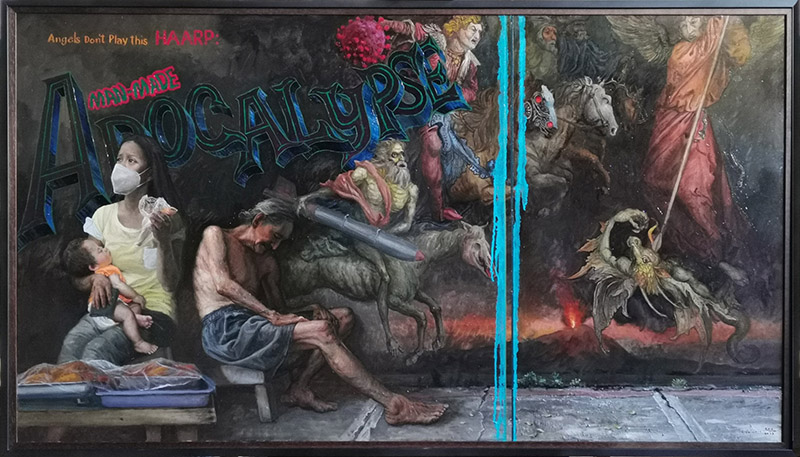
Look at Me: How Art Speaks When Words Cannot
by Ellysse Nadine Calma
When I was in high school, my brother took me to the National Museum of Fine Arts in Manila. He was studying at university at the time and decided that it would be a fun excursion for my family to “see the sights” in the big city. We walked through wood floors from the admitting hall to these arches that opened up to a beautiful atrium. There, in a thick black frame, I saw it in full scale: the infamous Spoliarium by Juan Luna.
It’s huge. I thought to myself, realizing that all the textbooks I have seen this painting printed on reinforced an idea that it would be minuscule, a fraction of its actual size. As I pondered on the symbols presented in the painting, its scale and grandiosity spoke volumes to me. The picture was meant to be loud. Just from size alone, you could tell that the artist wanted you to look at it. It was meant to convey a message so proudly that no one could miss it. The sheer size of the painting is enough to let eyes flock to it as if to say, “Look at me! I am right here!”
Visuals speak when words cannot, and Luna knew this painting the Spoliarium. His infamous work is an example of the power of art as a reflection of our lived reality and as a megaphone for issues present in the human condition. The connection between art and social commentary has permanently been established throughout history. As time tells us again and again, the juxtaposition of lines, colors, and shapes through art has always been used to reflect the human condition—to convey messages, spark conversation, and promote change.
Going back to ancient human times and the first instances of art-making practices, our earliest human ancestors used depictions of animals and human actions to reflect the reality of their experience. Using red ochre, black charcoal, and other primitive paints across rugged cave walls, they contrasted the bumps and rough texture of cave walls and bright paints to tell a story that was consistent with their way of life. Much of this art was not just used for narrative purposes, it was symbolic and perhaps even sacred to our early ancestors. Similar to contemporary art, early human artists used their work to relay messages and speak their truth.
Nowadays, hundreds of years into the future, modern-day artists continue to do the same thing—to create pieces that narrate the human condition in all its nuances, spaces, and experiences. Over history, artists have used this medium to express their reality in ways aesthetically pleasing, meaning-endowing, and hidden, especially during times of struggle.
There has always existed a connection between art and social change. After all, Botticelli thrived during the height of the Bubonic Plague—releasing Primavera as a way to distract people from all the death that was happening. Likewise, Realism as an art movement was born out of the dissolution of the French monarchy and consequently, the French Revolution—highlighting a turn away from the aristocracy and toward the layman. In the 1980s, the use of art was instrumental in highlighting the political issues of gay rights during the AIDS movement, showing once again the intersectionality of art in socio-political changes.
Art also has an amazing power to not only express things when words cannot, but also to allow us to remember events. Works such as the black-and-white photos of Rick Rocamora featuring portraits of Martial Law victims serve to remind the public that these events did exist and that they deserve to be remembered. The Messengers of Geo Engineering by Galicano, as featured in Tubô Cebu Art Fair this September, calls forth the same things. Putting forward art with intention and using such pieces, not only to highlight our human experience but to create conversation—to speak through symbols and color.

The Messengers of Geo Engineering, Galicano, 2023
Throughout the years, Tubô Cebu Art Fair has celebrated the intersectionality of art in different human endeavors. History also tells us that there exists an undeniable ever-present and ever-living connection between the artist and their lived reality. This year with the theme “Juxtaposition,” Tubô highlights different aspects of human life both in contention and in celebration with art. These aspects include but are not limited to fashion, literature, public spaces, and an aspect of the human condition: socio-political change. The beauty, aesthetic, and symbolism of art are further contrasted with our modern-day reality as many artists today continue to use this medium to spark conversations especially when words cannot be used.
Artists continually show that time and time again, they do have a place in history as not just chroniclers of events, but also as watchful eyes and fire-starters. Art has an endearing quality to scream, “Look at me! I am right here!” especially when words fail to reach volumes, and artists continually remind us that art has a say in our political landscapes as illustrations of the world we live in.
Catch Tubô Cebu Art Fair this September 15 to 17 at Ayala Center Cebu and watch as artists continue to speak through symbols, spark conversations with no words, and bring closer attention to things we have yet to see.
